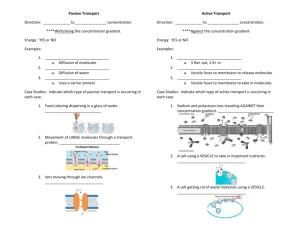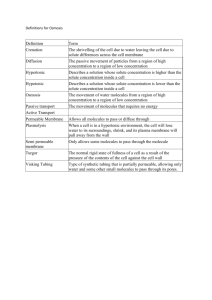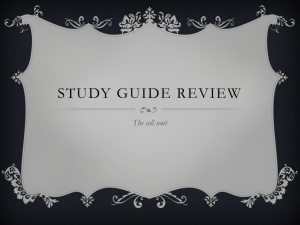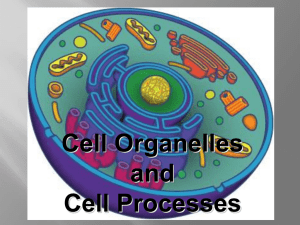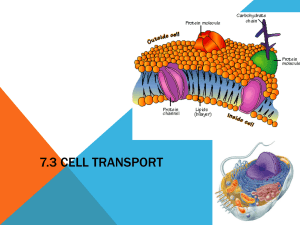Chapter 4 part 2
advertisement
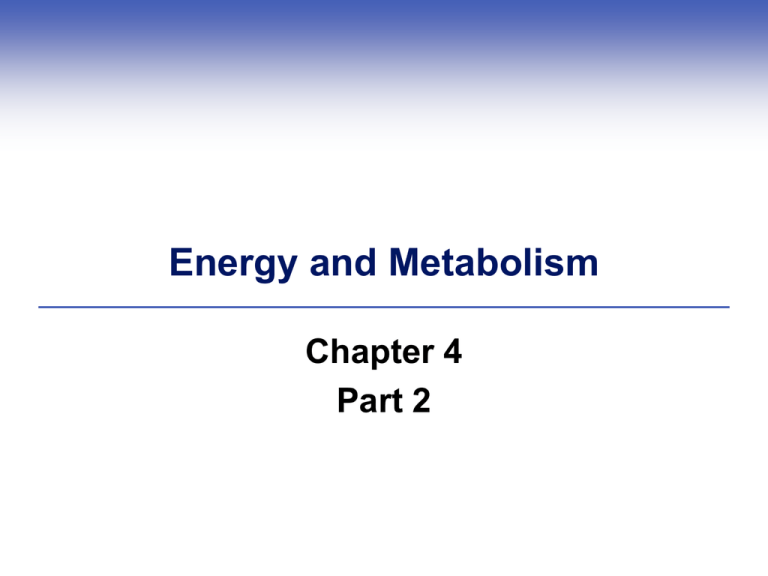
Energy and Metabolism Chapter 4 Part 2 4.5 Movement of Ions and Molecules For metabolism to work, a cell must keep its internal composition stable – even when conditions outside are greatly different Selective permeability • Membrane property that allows some substances, but not others, to cross Selective Permeability of Cell Membranes Diffusion Molecules or ions tend to follow their own concentration gradient and diffuse into an adjoining region of fluid in which they are less concentrated Diffusion • Net movement of molecules or ions from a region of higher concentration to a region of lower concentration Osmosis and Tonicity Water molecules tend to diffuse in response to their own concentration gradient Osmosis • Net diffusion of water molecules across a selectively permeable membrane between two fluids with different water concentrations Osmosis Osmosis and Tonicity Tonicity describes relative concentrations of solutes in fluids separated by a selectively permeable membrane • Hypotonic: Low solute concentration relative to another fluid • Hypertonic: High solute concentration relative to another fluid • Isotonic: Same solute concentration relative to another fluid Fig. 4-12 (a), p. 71 B Red blood cells immersed in an isotonic solution do not change in volume. The fluid portion of blood is typically isotonic with cytoplasm. C Red blood cells immersed in a hypertonic solution shrivel up because more water diffuses out of the cells than into them. D Red blood cells immersed in a hypotonic solution swell up because more water diffuses into the cells than out of them. Fig. 4-12 (b-d), p. 71 4.6 Membrane Crossing Mechanisms Gases, water, and small nonpolar molecules can diffuse across a lipid bilayer Most other molecules and ions cross only with the help of transport proteins, which gives a cell or membrane-enclosed organelle control over which substances enter and exit Transport Proteins Each type of transport protein moves a specific ion or molecule across a membrane The types of transport proteins in a membrane determine which substances cross it • Examples: glucose transporters, calcium pumps Passive and Active Transport Passive transport • Concentration gradient drives a solute across a cell membrane through a transport protein • Requires no energy input Active transport • A transport protein use energy, usually from ATP, to pump a solute across a cell membrane against its concentration gradient Passive Transport Extracellular Fluid glucose 1 Cytoplasm lipid bilayer Fig. 4-13a, p. 72 2 Fig. 4-13b, p. 72 3 Fig. 4-13c, p. 72 Active Transport Sarcoplasmic Reticulum Cytoplasm calcium A B C Fig. 4-14, p. 73 Cotransport Cotransporter • Active transport protein that moves two substances across a membrane in opposite directions at the same time Example: sodium-potassium pump • ATP powers an active transport protein that pumps Na+ out of and K+ into a cell Cotransport: Sodium-Potassium Pump Endocytosis and Exocytosis Endocytosis • Process by which a cell takes in a small amount of extracellular fluid by a ballooning inward of its cellular membrane Exocytosis • Process by which a cell expels a vesicle’s contents to extracellular fluid by merging the vesicle with the plasma membrane Phagocytosis Phagocytosis (“cell eating”) • Endocytic pathway by which cells such as macrophages and other white blood cells engulf particles such as microbes or cellular debris • Amoebas also are phagocytic cells Phagocytosis

